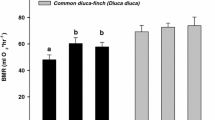Abstract
The hypothesis was tested that the reproductive performance of voles would be reduced when fed diets containing tannins either because of increased metabolic rates, decreased intake, or decreased digestive efficiency. We fed a ration containing 4% tannic acid (TA) (dry mass basis) to 24 pair of prairie voles (Microtus ochrogaster) and compared reproductive performance (litter size, birth weights, body mass of the young until weaning, and mass changes in the dams) to that of 24 pair of prairie vole fed a control ration. We also compared the intake rates, digestive efficiency, and metabolic rates [as measured by Vo2 consumption (cm3/hr)] of dams and young fed both rations. Voles consuming 4% TA diets produced litters of similar size and mass as did voles fed the control ration. Furthermore, the mass of the young of dams fed the tannic acid ration were similar to the young of dams consuming the control ration through day 19 postpartum. However, dams consuming the tannic acid ration lost mass throughout lactation while the control dams maintained mass. Because the Vo2 rates of both treated and control dams and litters were similar, we conclude increased metabolic costs were not the reason for the observed mass loss but, rather, reduced digestive efficiency, reduced intake of digestible dry mass, and apparent digestible nitrogen.
Similar content being viewed by others
References
Cole, F.R., andBatzli, G.O. 1979. Nutrition and population dynamics of the prairie vole,Microtus ochrogaster, in central Illinois.J. Anim. Ecol. 48:455–470.
Feeny, P. 1976. Plant apparency and chemical defense.Recent Adv. Phytochem. 10:1–40.
Innes, D.G.L., andMillar, J.S. 1981. Body weight, litter size, and energetics of reproduction inClethrionomys gapperi andMicrotus pennsylvanicus.Can. J. Tool. 59:785–789.
Lindroth, R., andBatzli, G.O. 1984. Plant phenolics as chemical defenses: Effects of natural phenolics on survival and growth of prairie voles.J. Chem. Ecol. 10:229–244.
Lindroth, R., Batzli, G., andGuntenspergen, G.R. 1984. Artificial diets for use in nutritional studies with microtine rodents.J. Mammal. 65:139–143.
Maynard, L.A., Loosli, J.K., Hintz, H.F., andWarner, R.G. 1979. Animal Nutrition. 7th ed. McGraw-Hill, New York.
Migula, P. 1969. Bioenergetics of pregnancy and lactation in European common vole.Acta Theriol. 13:167–179.
Ostle, B., andMensing, R.W. 1975. Statistics in Research. Iowa State University Press, Ames, Iowa.
Rhoades, D., andCates, R. 1976. Toward a general theory of plant antiherbivore chemistry.Recent Adv. Phytochem. 10:168–213.
Robbins, C.T. 1983. Wildlife Nutrition. Academic Press, New York.
Thomas, D.W., Samson, C., andBergeron, J. 1988. Metabolic costs associated with the ingestion of plant phenolics byMicrotus ochrogaster.J. Mammal. 69:512–515.
Author information
Authors and Affiliations
Rights and permissions
About this article
Cite this article
Meyer, M.W., Richardson, C. The effects of chronic tannic acid intake on prairie vole (Microtus ochrogaster) reproduction. J Chem Ecol 19, 1577–1585 (1993). https://doi.org/10.1007/BF00984898
Received:
Accepted:
Issue Date:
DOI: https://doi.org/10.1007/BF00984898




